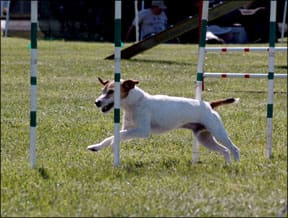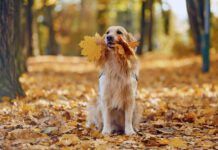[Updated October 5, 2017]
ACUPRESSURE FOR DOG INJURIES: OVERVIEW
1. Have a holistic veterinarian examine your dog after any injury debilitates your dog. More damage than meets the eye could have occurred, requiring surgery or other immediate treatment.
2. Watch your dog during your acupressure session. If he grows uncomfortable, stop holding that point and move on to the next point, or offer another session another day.
3. Concentrate on your “healing intention” for your dog while you work. Empty your mind of other distractions.
Maintaining a well-rounded training regime and providing incremental warm-up exercise before strenuous exercise are an important part of preventing injuries. But with any sport, the dog’s enthusiasm and natural drive can lead to incidental and repetitive injuries, despite our best prevention efforts. That’s why it’s best to formulate an approach to dealing with our dog’s injuries, before they happen.

With an injury that is severe and/or debilitating, a holistic veterinarian should be consulted immediately to diagnose the extent of the damage and prescribe treatment. Soft tissue injuries in particular can be deceiving, so have a veterinarian check your dog to be sure that no other issues or further tissue damage occurs. After the holistic vet has seen your dog and made the necessary recommendations or if the injury is a simple bruise or superficial abrasion, you can help expedite the healing process. Only the animal’s body can heal itself – but you can play a role in helping to create the physical “environment” in which healing can take place in a balanced, healthy manner.
Healing with Acupressure
Acupressure, like acupuncture, is based on traditional Chinese medicine (TCM) concepts that have helped heal animals and humans alike for more than 3,000 years. The basic principle underlying the healing process is that vital substances of the body nourish the body while moving harmoniously throughout the body. Two of the vital substances are chi (or qi), which is life-promoting energy, and blood, a nutrient-rich body fluid. In TCM, blood includes both the blood as identified in conventional medicine and other body fluids, such as synovial fluids in the joints or the nutrient-rich fluid within the spinal column.
Any injury can cause disruption in the flow of chi and blood. Using acupressure points, also called “acupoints,” you can help re-establish the flow of chi and blood through an injured area thus creating the healing environment. The movement of chi and blood through the damaged tissue helps distribute the nutrients the body needs to heal quickly and well.
“Surrounding the Dragon”
“Surrounding the Dragon” is an acupoint selection technique that is specifically for enhancing the flow of chi and blood to and through a particular location on the body. This technique is used often as an effective tool for tendon and ligament joint injuries as well as for chronic issues such as arthritis and tendonitis.
The “Dragon” is the painful, raging injury, arthritic joint, or site of scar tissue formation, which blocks the flow of chi and blood. Applying gentle pressure to specific acupoints surrounding the “offended” area stimulates the flow of the healing chi and blood while removing toxins and nourishing the tissues.
When Surrounding the Dragon, we stimulate acupoints located near – but not too close to – the insulted area because you do not want to “spank the crying baby.” This phrase is used in Chinese medicine to mean that you do not want to cause any further hurt when the area is already painful.
Acupoints and Technique
The photos below provide acupressure point combinations that address injuries or issues related to the shoulder and hip. All of the acupoints identified are considered “local” points and directly address bringing chi and blood to the identified joint.

Surrounding the Dragon can bring more chi and blood to the afflicted area whether it is an injury, scarring, or a chronic problem. These acupoint combinations can support the healing process, help reduce pain, and bring more flexibility to the limb. It’s an additional healing tool you can use when your dog suffers from a knock, repetitive injury, or twist, and you have followed your veterinarian’s recommendations.
Points that surround the injured area can be stimulated simultaneously or in succession, one acupoint at a time. By stimulating a point, we simply mean applying gentle pressure to the point with the soft, fleshy portion of the tip of your finger and thumb.
Gently place your fingers on the acupoints shown in the photos below, while holding your intentions to relieve the dog’s discomfort in the forefront of your mind. You do not have to apply much pressure since this is energetic work, not manipulation of tissue. Continue your contact with the point while counting slowly to 30, or until the dog moves away or demonstrates some form of release. Energetic releases can include yawning, licking his lips, stretching, passing gas, demonstrating the need to move, or even falling asleep.
Remember to repeat this procedure on both sides of the dog. If the dog gives any indication of pain, stop immediately and work the points on the other side of the dog. If the dog continues to be uncomfortable, try again at a later date when the dog is not as sensitive.
Amy Snow and Nancy Zidonis are the authors of animal acupressure texts, including The Well-Connected Dog: A Guide To Canine Acupressure; and Acu-Cat: A Guide to Feline Acupressure.






